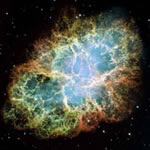Hubble sends a detailed image of the Crab Nebula
 This is an image of the Crab Nebula that looks like a giant mosaic made from Hubble telescope observations and accurately represents the rest of the cosmic material after an explosion of a supernova (giant star).
This is an image of the Crab Nebula that looks like a giant mosaic made from Hubble telescope observations and accurately represents the rest of the cosmic material after an explosion of a supernova (giant star).
This supernova explosion was observed 10 centuries ago, in 1054 by Japanese and Chinese astronomers. Located in the constellation of Niu, this nebula has also attracted attention in some Native American peoples.
This phenomenon is four times more luminous than observing Venus, so much so that it can be seen during the day for 23 days and at night for more than 650 days. Later this nebula was discovered by British astronomer John Bevis in 1731.
The Crab Nebula with a diameter of about 6 light years continues to expand at a rate of about 10,000 kilometers per second.
The nebula's mind is a Pun-distant, a neutron star that turns around itself very quickly. This very dense star is often the result of a supernova explosion. This neutron star works in the center of the nebula similar to a generator, making it highly bright.
The yellow and light green structures are the rest of the star that contains hydrogen. Light blue colors emitted by electrons at the same speed as light along the lines of the magnetic field.
- The most beautiful cosmic photos in 25 years
- Admire the beautiful array of astronomical images celebrating Hubble's 25 years old
- 15,000 galaxies in the Hubble telescope image
- Photographing Tarantula nebula from close distance
- Video: Picturesque Horse Head Nebula
- NASA shares incredible images of Bubble Nebula
- The Hubble Space Telescope records images of dying stars
- The most beautiful images of 2016 taken by Hubble glasses
- For the first time, determine the 3D structure of the nebula
- The nebula is like a giant crimson eye in the universe
- Pink nebula Omega
- Huge blue eyes in the universe
 Van Allen's belt and evidence that the Apollo 11 mission to the Moon was myth
Van Allen's belt and evidence that the Apollo 11 mission to the Moon was myth The levels of civilization in the universe (Kardashev scale)
The levels of civilization in the universe (Kardashev scale) Today Mars, the sun and the Earth are aligned
Today Mars, the sun and the Earth are aligned The Amazon owner announced a secret plan to build a space base for thousands of people
The Amazon owner announced a secret plan to build a space base for thousands of people